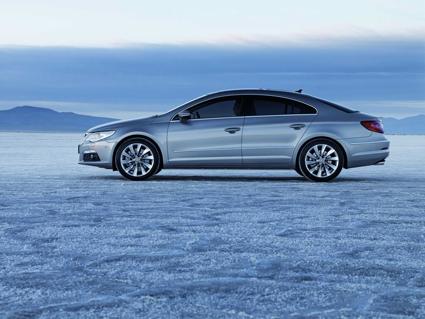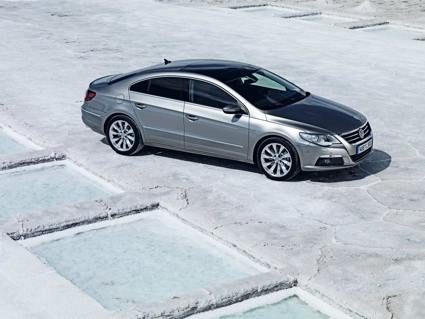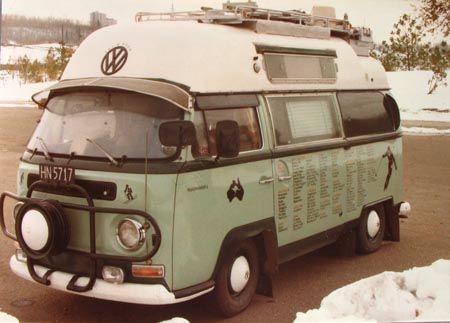Calgary Herald, People’s Test Drive 2009 VW Passat CC, by Greg Williams
This story first ran in the Calgary Herald Driving section, April 17, 2009
Photos in this post courtesy VW Canada.

Calgary bartender Allan Fraser has never purchased a brand new car.
That’s not to say he hasn’t had some nice vehicles. There was a succession of MGBs — he still owns one, in fact — and he drove a Mercedes-Benz for a few years.
Fraser, 54, just finds deals on older model cars, buys them and drives them until they no longer work. For example, his current car is a 1994 Ford Taurus, and it does everything he needs it to.
“It’s not much to look at, but it has been reliable,” Fraser says.
However, this People’s Test Driver may have been spoiled after a week in the 2009 Volkswagen Passat CC 2.0T.
“Would I buy one? I would have to say ‘yes’,” Fraser says. “I really enjoyed driving the Passat CC; I enjoyed everything about it.”
Brand new for 2009, the Passat CC — VW says the CC stands for Comfort Coupe — is based on the regular Passat platform. However, the Passat CC is definitely not to be confused with its sibling. The regular four-door Passt is still in the VW lineup, and the Passat CC is not a replacement. It is, however, a four-door car styled to look like a coupe, much like the Mercedes-Benz CLS.
While sharing the same wheelbase, the Passat CC differs from VW’s regular Passat in quite a few other dimensions, namely height, width and length. The Passat CC has a lower roofline, and sits lower on its haunches. The car is also wider and longer, and completely different looking with the smooth flowing lines and the aerodynamic shape of a two-door car.
Those lines found favour with Fraser.
“I thought it was very stylish and sporty looking,” Fraser says. “I thought it looked like it had been aerodynamically designed, and overall I liked the whole package.”
Fraser also thought the car looked comfortable, and fast. Which it was. The Passat CC is available with either a turbocharged 2.0-litre inline four-cylinder engine, or a 3.6-L V-6.
His car came with the 2.0-L four, and at the beginning of the test he thought it was the V-6.
“I was really impressed,” Fraser says. “That four-cylinder turbocharged engine puts out 200 horsepower, and it felt really powerful.”
The Passat CC is available in three flavours. There is the CC Sportline, which comes with the 2.0-L engine and a manual six-speed gearbox, and the CC Highline with the same front wheel drive powertrain but a few extras such as 12-way power driver’s seat, 18″ alloy wheels, Bi-Xenon headlights and a panorama sunroof. An automatic gearbox is optional in each.
There is also the CC 3.6-L Highline with a 260 h.p. engine coupled to a six-speed automatic, and that package includes VW’s 4Motion all-wheel drive system.
Fraser’s car was the 2.0-L Highline equipped model, and it featured the optional automatic with Tiptronic, a feature Fraser liked.
“I thought the Tiptronic was fabulous, it allowed me to shift the transmission like it was a standard,” Fraser says.
And Fraser enjoyed the ride. He used the car to commute back and forth to work from his Northwest home to Bearspaw, and he drove out to Kananaskis Country.
“I took it down a road that was ice and snow covered, and the traction control worked perfectly,” he says. “The car had really good traction, and I couldn’t upset the car at all.
“The ride was comfortable, and everything was quiet — it felt really tight and safe and it handled like a dream.”
The Passat CC rides on independent McPherson struts up front, and fully independent four-link suspension out back. Volkswagen lists ‘Sport Suspension’ as standard equipment across the CC range.
Fraser enjoys skiing — in fact, it was the slopes of the Rocky Mountains that brought him from his Cape Breton Island home to Calgary in 1976.
“I had some friends in Calgary, and I heard there was work here, and that the skiing was the best in the world — and it is. The skiing kept me here, and I’ve never been unemployed — I’ve always had a job,” he says.
Because he likes to ski, it’s important that any vehicle he drives has the capability to carry skis. With a rear seat pass through, Fraser says the Passat CC would definitely swallow his skis. The car did carry his hockey gear, including sticks, with aplomb.
“The trunk was very big,” he says, and adds. “I liked the fact there was a full-size spare tire in there, too.”
At 5’8″ Fraser found getting comfortable in the driver’s seat an easy task — he says the power seat with memory function moved in every direction and was extremely supportive. He had plenty of legroom, and says his nephew, who is 6’1″, also had plenty of room to store his knees while traveling in the front passenger seat.
That being said, Fraser did find the car a little awkward to get into, and more than once just missed hitting his head as he slid into the driver’s seat.
“Once I was in, though, it was a perfect fit,” he says.
In the past, Volkswagen has taken some criticism for not designing particularly welcoming interiors. Fraser says that’s not the case with the Passat CC. He liked the Nappa leather seating surfaces, and says the cabin materials were first rate.
“One of the first things that really stood out for me was how well put together the car really was,” Fraser says. “Everything was easy to see and use — the dash was laid out simply, and the heating and A/C controls were a snap to operate.”
Fraser drove himself and three co-workers to the city’s southwest in the Passat CC. All remarked on the comfort of the ride, and especially from the rear seat, the amount of available room.
“I became more and more impressed with the car from the time I got it to the time I took it back,” Fraser says, and adds, “I never had a negative comment from anyone I showed it to, everybody was impressed with the interior, the style, the get-up-and-go.
“It was really a tremendous vehicle.”

SPECS
Engine: 2.0-L I4 16-valve DOHC turbocharged
Horsepower: 200 @ 5,100 – 6,000r.p.m.
Torque: 207 lb.-ft. @ 1,700 – 5,000 r.p.m.
Wheelbase: 2,710 mm
Overall length: 4,796 mm
Curb weight: 1,530 kg
Base price: $27,975
Price as tested: $40,835
-30-
ALLAN FRASER’S JOURNAL
For the past week, I had the marvelous experience of driving the 2009 Volkswagen Passat CC.
I picked up the car in Chestermere and drove it back to town. I enjoyed the way it looked, sounded and handled.
The Passat’s engine was a turbocharged four cylinder, which produced plenty of power. Its transmission was an automatic with Tiptronic system. I really enjoyed this feature as it allowed me to shift it up and down like a standard.
The exterior was very stylish with fine lines that suited the car perfectly. The doors and windows closed nice and tight making it feel very solid. The front hood opened and closed also very easily. The car’s trunk was very spacious and with the opening between the back seat one can carry skis and hockey sticks easily. The interior was great. Everything was within reach and it was easy to operate all the controls.
The power seats were very comfortable with plenty of legroom in both the front and back. Air conditioning was great and the heated seats were definitely a bonus with the cold weather.
At night I found all of the instruments and controls were distinctively lit up so that I could still find and operate them. With the changing driving conditions of snow, rain, warm and cold, the car handled and felt to be top notch.
One evening, there was a terrible snowstorm with drifting snow and when I drove home from work the Passat CC got me there safely with comfort and ease.
Overall, I had a considerable amount of fun driving the Passat this week. The time went fast just like the car. I believe the car to be a fine example of the People’s Car.

